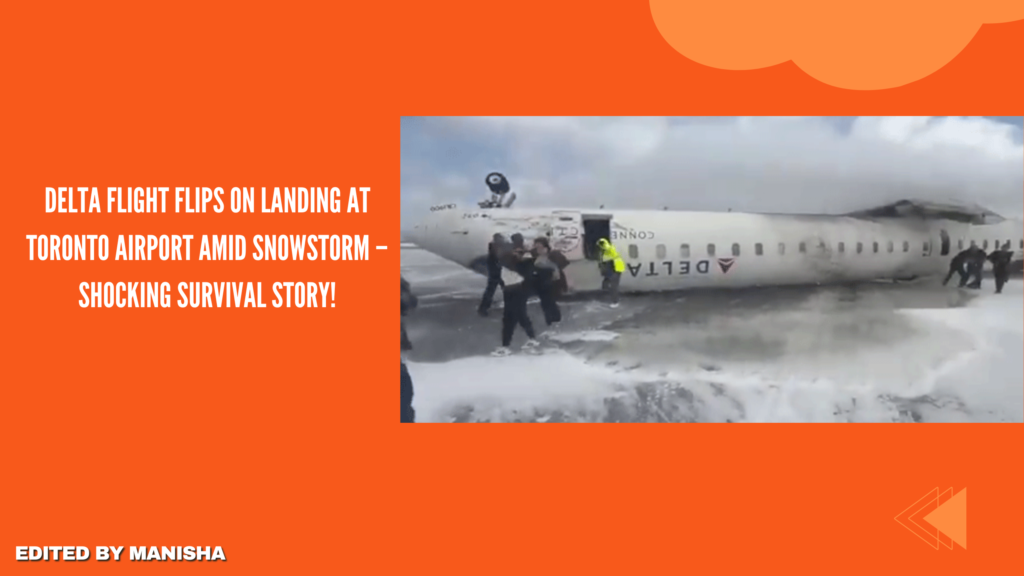
A Delta Air Lines passenger plane flipped upon landing at Toronto Pearson Airport amid heavy winds and snow. Survivors were seen walking away from the wreckage, shielding themselves from strong gusts of wind.
What Happened?
Delta flight 4819, which had taken off from Minneapolis, Minnesota, at 11:47 AM local time, was en route to Toronto Pearson Airport, cruising at 29,000 feet. Upon approaching runway 23 at about 2:15 PM, air traffic control warned the pilots about a possible airflow disturbance due to another aircraft ahead of them. No further communication took place with the Delta flight until the tower confirmed the plane had overturned during landing amid poor weather conditions following a snowstorm.
Passenger Pete Koukov shared with CNN that he wasn’t aware of the problem until the plane hit the ground. He said, “We hit the ground, and we were sideways, and then we were upside down hanging like bats. Just feeling lucky and happy I got to give the person I didn’t know sitting next to me a big hug that we were OK.”
Videos show passengers walking away from the aircraft, which was missing its tail and at least one wing.
How Many People Were Onboard?
There were 80 people on the plane, including four crew members. Toronto Pearson President Deborah Flint confirmed that 22 of the passengers were Canadians.
Were There Any Injuries?
At least 18 passengers sustained injuries, according to Peel Regional Paramedic Services. Three of them were transported to the hospital in critical condition: a child, a man in his 60s, and a woman in her 40s. However, none of the injuries were considered life-threatening. Delta Airlines confirmed no fatalities. The airline expressed their focus on taking care of those impacted, with emergency responders at the scene praised for their swift and professional response.
How Did the Plane Flip Without Fatalities?
Aviation expert Keith Tonkin noted that it was fortunate all passengers were safely evacuated. He speculated that the requirement for passengers to wear seatbelts during landing likely played a crucial role in preventing fatalities. John Cox, an aviation safety expert, pointed out that seeing an aircraft resting upside down is very rare, though similar incidents have occurred during takeoffs.
What Caused the Plane to Flip?
While the exact cause of the plane flipping is still under investigation, weather conditions likely played a role. The area was experiencing icy, windy, and freezing conditions following a snowstorm. At the time of the landing, blowing snow and winds of 27 to 35 knots (about 60 km/h) were reported, and temperatures were around -8.6°C (16.5°F). Experts believe that the snowy and gusty winds may have hindered the pilot’s ability to maintain directional control during the landing.
Airport officials, however, indicated that the runway itself was dry with no crosswind conditions. Cox disagreed, stating that there was an average crosswind of 19 knots (35 km/h) during the landing, with gusts fluctuating in strength, which would require pilots to constantly adjust speed, vertical profile, and lateral profile.
What About the Missing Wing?
The plane was notably missing its right wing. Cox explained that if one wing is lost, it would make the aircraft prone to rolling over, which may have contributed to the plane flipping.
What Type of Plane Was Involved?
The aircraft was a Bombardier CRJ-900, a regional jet owned by Endeavor Air, a subsidiary of Delta Airlines. This plane is part of the same aircraft family as the CRJ-700, which was involved in a midair collision near Washington D.C. last month.
What Happens Next?
The investigation into the incident is ongoing, with the Transportation Safety Board of Canada taking the lead. The U.S. National Transportation Safety Board will send a team of investigators to assist with the inquiry.